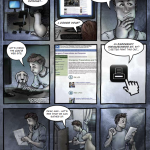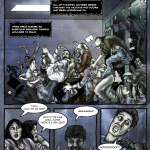The Cultural Life Of The Living Dead
Zombie attack?
No, we are not physically surrounded by half-rotted corpses yearning for our sweet braaaaaaains; but, zombies in popular culture are suddenly ubiquitous, from television shows such as AMC’s The Walking Dead and the National Geographic Channel’s The Truth Behind Zombies to movies like World War Z and Warm Bodies, along-side countless zombie books, video games, and pub crawls.
Zombie movie culture amuses via comedies like Zombieland, scares via movies like Resident Evil, and evokes feelings of despair via movies like I Am Legend. Directors such as George A. Romero have taken the genre to new levels of availability. In organized “zombie walks,” people dress up and shuffle about town for a few fun hours, while in zombie runs and zombie hunts, people pay event organizers to be chased by actors dressed in tattered rags and decaying “skin.” Even just saying you “feel like a zombie” has specific meanings—we conjure images of slovenly or sluggish appearance or behavior.

Although zombie fiction has only recently saturated movies, television, and even government preparedness websites, zombies have been a part of folklore for as long as stories have been told. In the Bible, Lazarus is a zombie brought forth by Jesus, and the contemporary zombie myth comes from the folklore of Africa and Haiti. Zombies are used as an analogy to connote fear and elicit revulsion toward apathy and sloth. They are also used as a cultural object that inspires activities (zombie-themed social gatherings).
Because of the popularity of this genre, mainstream commercial retailers and governmental agencies alike have taken note, going so far as to feature zombies in public campaigns. The Centers for Disease Control (CDC)’s tongue-in-cheek disaster preparedness campaign slogan was: “If you’re ready for a zombie apocalypse, then you’re ready for any emergency.” The CDC admittedly created the campaign as a marketing tool to engage a larger audience; its success led to even wider distribution and an expansion of the campaign. Now, the CDC website offers zombie preparedness tools to educators, comic book fans, and social media users, cleverly providing actual emergency information in an entertaining format. By the mere creation of the CDC’s zombie campaign, the government agency tells audiences that they should prep for a hurricane, too—it’s just as likely to turn lives upside down as any zombie invasion.
The strategy works. When zombies are mentioned, people pay attention, even if only out of morbid curiosity. Doritos, FedEx, Starburst, Converse, and Chevrolet have used zombies in their marketing at one time or another. For businesses and governmental agencies, tailoring campaigns to impact target demographics is one way to get their messages heard by a larger audience.
Zombies As Cultural Critique
Zombie culture is also, in its own way, a widespread cultural critique. In “Dead Man Still Walking: A Critical Investigation into the Rise and Fall… and Rise of Zombie Cinema,” literary and film scholar Kyle Bishop explains how the zombie metaphor reflects consumerism, public health, and politics. In our consumer culture, people live to consume and work so we can afford the material goods we consume, as exemplified in Romero’s Dawn of the Dead. In this film, zombies try to break down the doors of a mall so they can shop. The objects zombies consume change from luxury goods to people; the irony is not lost on many zombie fans.
The indoctrination of youth via the education system is another example of zombism in our society; when young people are taught to memorize facts and prepare so they may perform well on standardized tests, thinking is not required. Like zombies, the students aren’t expected to think, just “do.” Other zombie analogies include food consumption: headlines lament the United States’s obesity epidemic and link it to the consumption of fast food and empty calories. We eat junk food, yet we do not satiate our nutritional needs. Thus, we eat more and more, mindlessly eating until we die, like zombies, who are often depicted with an unquenchable drive which needs to be fulfilled even though it may lead to the zombie’s undoing.
In this way, zombies are the cultural monsters that symbolize our social woes. In The Culture of Fear, sociologist Barry Glassner noted that our collective cultural fears are directly related to guilt about overlooked social problems. Glassner says social panics are “constructed out of random scraps of myth, propaganda, wishful thinking, prejudice and fear.” And prejudice and fear are major themes in most zombie fiction—zombies are the “other.” If you cannot chop off zombie heads fast enough, you become them. If all humans become zombies, humanity is lost. No wonder zombies are terrifying.
Glassner also explores why certain social dangers are emphasized at particular times. He concludes that exaggerated social dangers “enable criticism of disliked groups and institutions.” In most zombie fiction, the zombies begin as a small population, but because humans can’t control their spread, the zombie population soon overtakes humans. Does this sound like some recent political arguments? Anti-immigrant groups believe that if “we” fail to contain immigrants now, at some point, there will be more immigrants than natural-born citizens in the United States. It would be a takeover of the “other.”(Ironically, this is exactly what happened when European immigrants took over much of North America.) Zombies help to not only highlight this fear, but also allow people to distance themselves from xenophobia: fearing a monster is almost certainly more acceptable than fearing other people.
Preparing For The Zombie Apocalypse
In February 2013, Montana hackers took over a local television station, George Orwell-style, to announce that the dead were rising. The “other” had arrived. Some people were genuinely convinced that the zombie apocalypse had arrived.
That same month, the Washington Post reported that, in the Canadian House of Commons, representatives had discussed working with the United States to prepare for the zombie apocalypse. Although this was just a bit of fun, it highlighted how pervasive zombies had become in social discourse. Also in 2013, scientists at New Mexico’s Sandia National Laboratories created “zombie cells” that functioned much like living cells, though they were not “alive.” These cells could have been called anything— say, “pseudo-cells,” or like most scientific discoveries, some bastardization of the name of the scientist who discovered the cell’s function. It remains unclear whether the media or the scientists dubbed them zombie cells, but cultural weight was surely involved in both the moniker and its replication.
The zombie myth pervades cultural narratives because it helps people distance themselves from criticizing actual social problems—while helping to highlight potential social problems. Consumption culture is one of the primary zombie analogies, though others include xenophobic fears of people who do not resemble “us,” unquestioning acceptance of potentially harmful governmental policies (for example, the Patriot Act), a lack of disaster preparedness, mindless attention to technologies like cell phones, and ultimately a loss of whatever connects us to other humans.
If the soul is what makes us human, zombie life is a separation from our humanity. If society follows the trajectory illustrated in zombie fiction, we will literally become soulless, and humanity will cease. Planning for the zombie apocalypse may be an actual attempt at community solidarity, less the silly preparedness campaign it’s been presented as, and more an actual attempt at social cohesion. Or it’s just good fun.



